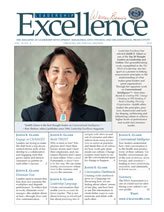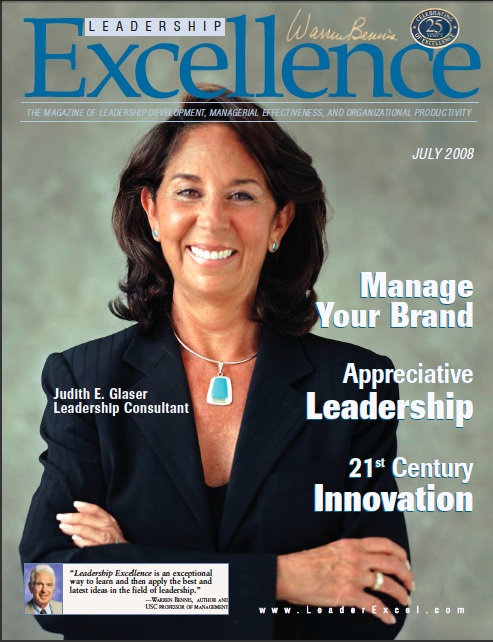By Judith E. Glaser | Leadership Excellence
Published March 2011
Share power with others.
People are often resistant to change because they think change means changing themselves. Many of us have a fear of change – but I think it’s actually something deeper than fear of change. Under the surface, for many people change is really a fear of loss. Our mind plays many tricks on us. Change = fear = risk=loss=loss of status. It’s all hardwired.
That is why I wrote The Leadership Secret of Gregory Goose. Gregory is a goose on a journey to discover his power to become a lead goose.
Most humans don’t knowthat geese get promoted. After all, geese don’t move to a bigger office, the sign on the door doesn’t change …and there are no big paychecks. Becoming the lead goose happens over time through careful observation of other lead geese. Gregory studied all his life, and knew the power rules instinctively well… or so he thought …
Power Rule #1: Power comes from how strongly you flap your wings. Positional power is instinctual, and Gregory hadbecome quite good at reading the subtle power signs. He knew that there was a special way that geese flap their wings when other geese are around. Powerful flaps tell other geese you are in control.
Power Rule #2: Power comes from how loudly you honk. Power also comes from power honking. Lead geese had honks that rose above the noises of the pond and created echoes over the horizon letting other geese know they had the power.
Power Rule #3: Power comes from how much you honk. The more powerful geese honk more often, and they also honk over other geese causing them to be silent.
Power Rule #4: Power comes from how well you strut. The more powerful geese have a way of lifting their ‘legs’ over the rushes and the rocks, strutting over the most dangerous terrain.
Power Rule #5: Power comes from how fast and strong you are. Powerful geese get the food first, so Gregory built a well-honed repertoire that combined swimming and flying to give him the edge he always dreamed of.
Power Rule #6: Power comes from your ability to peck. Pecking is the truest test of a goose’s power. The best peckers do not dismantle feathers as much as scare others to submission.
Power Rule #7: Power comes from how well you keep other geese in line. Being out in the front – that’s what a goose lives for. But being in the front looking back created new and different challenges that Gregory had not been aware of before; he was now responsible for the success of others.
Gregory diligently practiced the Ground Rules at the pond. By watching other lead geese, he believed strongly that having ‘power-over others’ was what leadership was all about.
Yet one day, the hunters came to the pond and started to shoot at all the geese. In a time of crisis, Gregory discovered all the Power Rules no long served him well. While in the air, Gregory made a ‘leadershift.’ He turned to the other geese – trusting them to become leaders, and they did. They split their “V” into three and the hunters didn’t catch one goose that day. Gregory called this ‘power-with others’. He discovered his most important wisdom – sharing power releases the leadership instincts in others.
Or so he thought!
For years I’ve been coaching and consulting to tough, smart leaders who are really comfortable using “honking, pecking, and strutting” leadership behaviors. They don’t want to let go because these behaviors are tied into their positional power. They don’t want people to think they are weak.
As part of our work, leaders and I talk about what ‘goose’ behaviors represent and how they affect their ability to achieve their main business objectives. It’s quite amazing what insights come out ofthis conversation.
Often leaders will realize that when they are using power-over behaviors, the impact is that employees become ‘followers’; they obey without question, and do not take risks. Instead of building high trust, organizations that are willing to experiment and try new things, they end up with a compliant organization where fear of change is rampant - just the opposite of what they want to achieve.
Once leaders see there is a direct connection between their “power-over” leadership style and the results they are getting from their employees, they are free to change.
Within a short while, something miraculous happens; their team’s resistance to change dissolves and productivity reins. This is a perfect example of how effective the Gregory model can be.
From Power-over to Power-with
Gregory offers a way to get anchored in a new type of leadership, which is ‘moving from power-over to power-with’. Following the Gregory Workshop I recommend a process of peer coaching that involves having leaders who have gone through a Gregory Session together, meet on a regular basis - every six weeks or two months - where each of them commits to doing experiments using the seven new leadership behaviors that they want to model.
Leaders learn to share their experiences with each other and talk about the results that they’re getting. This process creates a living organization that’s really committed to a different type of leadership, and the stories the leaders share are crystal clear, real-life examples of what people are actually doing so they learn from each other about dramatically new and exciting ways to lead. The leaders become coaches to each other using their real life examples as their coaching tools.
Today, performance expectations and reward processes are being changed to reflect this new leadership model. We are moving from punishment as a tool for change, to inspiring people to change. We’ve learned you can’t demand people to change, or force them to change. You can’t just use your positional power as a leader to create change. In the world today, employees don’t respond to these fear-based motivational tools.
What people do respond to is candor and caring. Let’s all agree that this is the truth. Let’s not play with each other. Let’s be candid with each other; and then let’s support each other in going through the steps of being the best that we can be. Let’s learn to catch each other when we get caught in old leadership mythologies that aren’t true any more.
As Gregory says, “When you give up power you get power.” Sometimes leaders get stuck inside the old paradigm of leadership – even when they know it doesn’t work and nobody really wants it. Power-over others deceptively feels good even if it’s not good for us.
I like the idea of teaching people to be honest about what leadership is really all about and what incredible results we can get with others when wetrigger the leadership instincts in others. When people have candor about who they are, and when they can catch themselves honking and pecking and strutting, then something differenthappens. You’re not pointing the finger and saying, “Let’s change this person.” You’re saying, “Oh my gosh! Look what I’m doing!” And that self-awareness in leaders is critical for sustainable change to take place.
Word Create Worlds
So to help you along your leadership journey, here are some definitions of newwords you need to know:
- Co-creating – Partnering with employees, peers and colleagues to work together and shape the organization’s success. Discouraging “we-they” thinking. Setting a positive and inclusive tone; creating a sense that “we are all in this together.”
- Leadershift – Adopting a new perspective on a difficult situation. With this newperspective, you see strategies and actions clearly as you had never seen before. Along with the shift in perspective, you also see change in your behavior and communication with others. This shift creates a shift in others.
- Power-With Others – An inclusive style of leadership where individuals work in concert with others to expand power, and frequently resulting in higher levels of productivity.
- Power-Over Others – An exclusive style of leadership characterized by dominance over others, frequently resulting in lower levels of productivity. The leader’s power is often derived from their position and status in the hierarchy.
- Co-creating Conversations® – Conversations that strengthen rather than weaken relationships; conversations that expand rather than limit possibilities; conversations that are appreciative rather than judgmental. In Co-creating Conversations, we seek to partner with others and build mutually empowering relationships.




